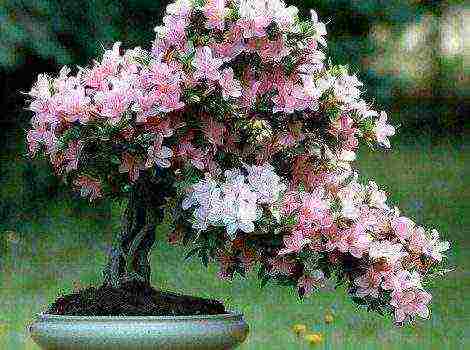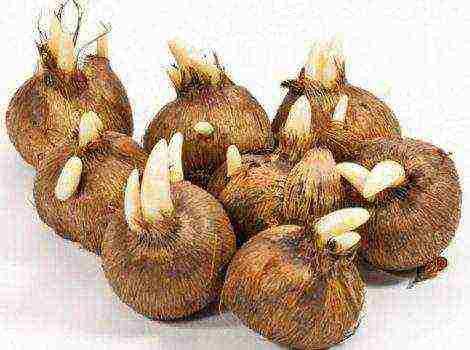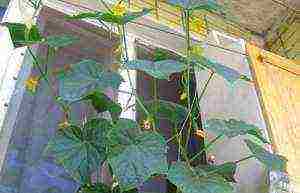Content
- 1 General information about lemongrass, description
- 2 Stratification, sowing seeds
- 3 Growing lemongrass: seed stratification
- 4 Growing lemongrass for a good harvest
- 5 Features of the cultivation of Chinese magnolia vine in Siberia, the Urals and the Moscow region
- 6 Planting a plant
- 7 Lemongrass care at home
- 8 Plant diseases and pests
- 9 Collection and storage of lemongrass fruits

This culture is propagated by seeds and vegetatively - by segments of rhizomes, dividing a bush, green cuttings and root shoots. But to obtain a large number of seedlings, it is safer to use the seed method.
Seed preparation
For breeding lemongrass, it is better to take freshly harvested lemongrass seeds. Before sowing, they are soaked in water for 6-8 days. On the second day, the floating, frail and damaged ones are removed. Then the seeds are mixed with wet sand (1: 3) and kept for a month at room temperature. The sand should be wet.
To stimulate faster germination of seeds stratify within 2-2.5 months: put in snow or freeze in a refrigerator at -5 ° C. As a result, about 60% of the seeds are pecked.
Sowing
Seeds sow in boxes or other containers in a mixture of humus and sand (1: 1): laid out on the surface of slightly compacted soil and sprinkled on top with a layer of earth of 0.5 cm. The soil is moistened and made sure that the top layer does not dry out. Seedlings appear in 1-2 weeks. They are slightly shaded and watered 1-2 times with a light pink solution of potassium permanganate.
Sow stratified seeds can be directly into the ground, into the grooves in a pre-prepared area. Embedment depth - 1.5-2 cm, distance in row spacing - 15-20 cm. After glaze grooves are mulched with peat.
Growing seedlings
In the phase of 2-4 leaves, seedlings dive at a distance of 3-5 cm from each other.
Seedlings grown in an apartment or greenhouse, planted in the ground after the last spring frosts and for the first time they shade. For the winter, the plants are covered with dry fallen leaves, sawdust or spruce legs.
After 1.5-2 years, lemongrass can be transplanted to a permanent place in the garden. Before planting, carefully prepare the soil. For one planting pit, 5-6 kg of humus, peat or compost, 15 g of nitrogen fertilizers and 30-40 g of superphosphate are taken. The best planting time is early spring.

Schisandra chinensis fruit
Care basics
Chinese schisandra - light-loving plant and does not bear fruit with strong shading. Liana is also demanding of fertility. soil, does not tolerate excessive moisture. With a lack of moisture, the leaves droop. Therefore, during the summer, the plants wateredand the soil is kept loose. This is especially important in late April and mid-October. Loosen the earth to a depth of no more than 5-6 cm, since the root system of Schisandra chinensis is located superficially.
The soil under the bushes of Schisandra chinensis mulch leafy ground. After spring loosening, lemongrass is desirable feed infusion of mullein (1: 6). Top dressing is poured into circular grooves 3-4 cm deep - 0.5-1 buckets per bush. And after 7-10 days, they are fed with full mineral fertilizer. In the third year, plants grown from seeds begin to bear fruit.An adult specimen produces about 5 kg of berries.
Schisandra chinensis is an indispensable plant for people suffering from hypotension (low blood pressure). It is easy to make medicinal syrup from it. Squeeze juice from lemongrass berries, mix it with sugar (1: 1.5) and bring to a boil. It is better to store it as a roll in the refrigerator, in small jars and drink it every morning, adding it to tea (to taste).
Download Original] ’class =" imagefield imagefield-lightbox2 imagefield-lightbox2-resizeimgpost-500-500 imagefield-field_imgblogpost imagecache imagecache-field_imgblogpost imagecache-resizeimgpost-500-500 imagecache-field_imgblogpost-resizeimgpost-500-500 ″>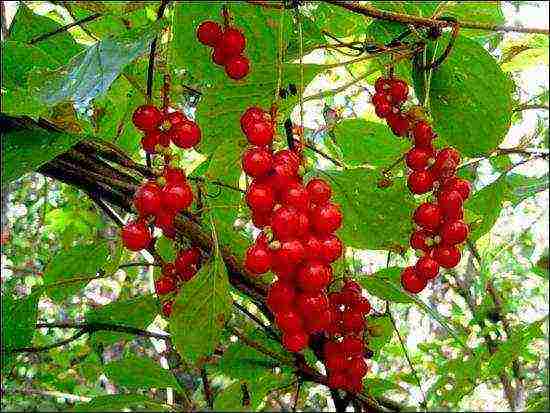
Plants of the Schisandra family are represented in the wild by more than twenty different species. Natural habitats are the Far East, China, Japan, India, USA.
In the wild nature of the Russian Far East, only lemongrass grows, the beneficial properties of which have been known to the indigenous people since ancient times. Thanks to them, as well as their rather decorative appearance,
the plant is gaining popularity
in amateur gardening.
For breeding, cultivars have been bred, adapted to the climatic conditions of Russian regions. Schisandra chinensis - growing from seeds today is available to many gardeners, and not only to those who were able to get the seeds of a wild plant or bring a seedling from the taiga.
Content:
- General information about lemongrass, description
- Stratification, sowing seeds
General information about lemongrass, description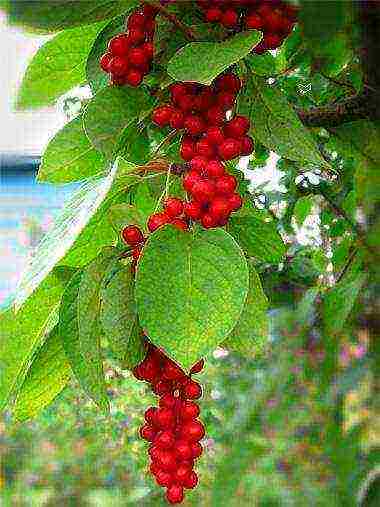
Schisandra chinensis, which grows in Russia, is a tall, deciduous vine. Strong, very elastic vines reach a height of more than 10 - 12 m. The vines grow around a suitable support, in the forest these are tall trees. Most often they grow in mixed, coniferous - deciduous forests. Prefers drier locations with good
drained soils
.
Liana is covered with brown - red bark, on adult plants the bark peels off and curls up, young shoots have a smooth yellow bark.
Lemongrass blooms in May, pink or cream flowers are collected in long brushes.
The flowers are dioecious, sometimes only male flowers can be on one liana, and in this case there is no harvest of berries. There will be no berries on the female plant if there is no pollinator nearby.
After flowering, the male flowers fall off, and in place of the female flower, a brush is formed - a polyberry, up to 12-15 cm long, sometimes up to 40 berries are collected on one brush. The berries are bright red or bright orange, inside they contain a convex hard seed, which is similar in shape to a human kidney.
Brushes with berries firmly adhere to the vine and remain on it until deep winter.
All parts of the plant have a weak lemon aroma, and the berries, due to the high content of vitamin C, citric, malic, tartaric acid, have a sour taste.
In the wild, lemongrass thickets are renewed mainly vegetatively, less often by seeds. In order to grow lemongrass from seeds at home, the seeds must be prepared in a special way.
Stratification, sowing seeds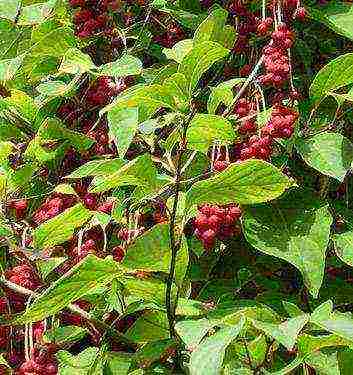
To
lemongrass seeds
sprouted, they must be prepared and subjected to the process of stratification.
The best results are obtained by the method when the berries harvested in the fall are stored whole, without removing the pulp from the seeds. In early January, the seeds of Schisandra chinensis are cleaned of pulp, thoroughly washed off its remnants with water.
The washed seeds are completely immersed in cold water, which must be changed several times a day. The soaking process continues for four days. At this time, sand is prepared, which must first be washed and then calcined well. The seeds are buried in it by placing them in a nylon cloth.
The box with sand and seeds is kept warm at a temperature of + 20 degrees for thirty days. After that, he is taken out into the garden and buried in the thickness of the snow. In the snow
seeds should
also spend thirty days.
After a period of exposure in the cold, the box with lemongrass seeds should be kept for 10 - 14 days in a cool place, at a temperature not exceeding 10 degrees. As a result of this preparation, the hard seed coat begins to crack, which facilitates germination.
For sowing, special boxes or containers are prepared.
To fill them, one part of the sand is mixed with one part of the humus. The seeds are laid out on the surface, after which they are sprinkled with a layer of soil half a centimeter thick.
Everything is well moistened, and in order to maintain the humidity regime, they are kept covered with a sheet of paper. With daily watering, the first shoots should appear in 10 - 12 days. During the germination period, seeds and seedlings are susceptible to fungal diseases; to prevent infection, it is necessary to spill it with a pink solution of potassium permanganate once or twice.
The first embryonic leaves of lemongrass look like cucumber shoots, when the fourth - fifth true leaves appear
seedlings dive
either in separate containers, or in a common box at a distance of at least five cm from each other.
The seedlings are planted in a permanent place in early June. It is important to remember that in the first three to four years lemongrass does not tolerate direct sunlight and it is advisable to cover it from them. In addition, as it grows, it will need vertical support, otherwise the seedling will begin to bush and give numerous root shoots and will not bloom.
Lemongrass grown from seeds blooms quite late, around the seventh year, but this method has an advantage over the vegetative method of propagation, since in most cases the plants obtained from seeds have both male and female flowers, which allows you to get a harvest even with one vine.
The following varieties are recommended for cultivation in amateur gardens:
- Firstborn
- Purple
- Mountain
- Garden
- Oltis
Schisandra chinensis is an excellent plant for vertical gardening, in addition, berries, seeds, and parts of lianas are widely used in folk medicine as a fortifying agent, to normalize blood pressure, increase immunity.
Growing and properties of lemongrass in the video:
The cultivation of lemongrass will be more successful if the seeds are sown in the fall. In this case, you will only need to sow lemongrass fruits in the prepared place, and wait for shoots in the spring. If you have to sow in the spring, the seeds need to be prepared.
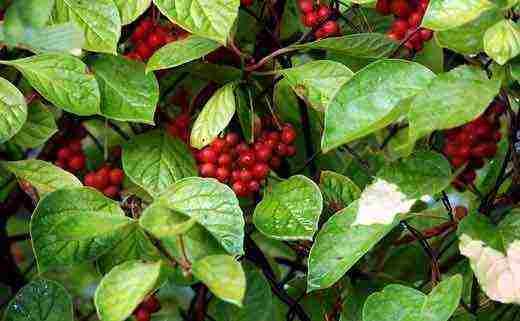
Under natural conditions, such preparation occurs by itself: Schisandra seeds from fallen fruits are for a long time on "rest" in the cold ground and in spring they germinate naturally.
If you start growing lemongrass in the spring, the seeds need to be stratified, that is, they need to be carried through all the periods that they experience in nature.
Growing lemongrass: seed stratification
You can do this. In January, extract lemongrass seeds from the fruits, wash them from the pulp. Soak for 4-5 days in warm water, changing it every day. Then put the lemongrass seeds in a cloth and bury them in a container (box, pot) with wet sand. Place the container in a warm, but not hot place (+ 18-20 degrees). This is the "warm" part of stratification.
After 1 month, the container where the lemongrass seeds are located must be buried in the snow. Sketch a snow ridge higher on top so that the seeds do not freeze. This "cold" part of the stratification also lasts 1 month. If there are few seeds, you can wrap them in a damp cloth, and then in plastic, and keep in the refrigerator for 30 days, sometimes taking out the bag and dampening the cloth.
After that, a container with seeds or lemongrass seeds in a plastic bag is brought into a cool (+ 8-10 degrees) room (veranda, balcony, etc.). After ten days, their shell already begins to crack. It remains to sow Chinese lemongrass in a box with loose earth (with the addition of humus and sand).
Growing lemongrass for a good harvest
When the lemongrass seedlings sprout, take care of the same as for ordinary seedlings: water, cut open in the phase of 4 leaves. Chinese lemongrass is planted on the site in early June, when there is confidence that there will be no return frosts. Chinese lemongrass is frost-resistant, but it is better to cover young plants in late autumn with breathable material: for example, dry leaves. After two years, they can be transplanted to permanent places.
Growing lemongrass is more successful in loose fertile soil, in areas where water does not stagnate.The plant, which bears fruit, has both male and female flowers, but, as a rule, its own pollination is not enough for it, therefore the "single" Chinese lemongrass gives a small harvest. To increase the yield, you need to plant a group of lemongrass on the site (at least 2-3 plants).
|
Leave your review |
|
| I am not a robot. | |
|
send
Reset |
|
Average rating: 0 reviews
Tags:
bonsai hyacinths boxwood
The plant belongs to the Lemongrass family of the genus Lemongrass, and today it is grown throughout Russia. The fruits of woody liana have medicinal properties valuable to humans. Growing schisandra chinensis and caring for it is within the power of even a novice gardener, if you know well the agricultural technology of the plant.
Features of the cultivation of Chinese magnolia vine in Siberia, the Urals and the Moscow region
The plant is sturdy and able to adapt to various climatic conditions. The culture is cold-resistant and does not die even in a frost of -40 C.
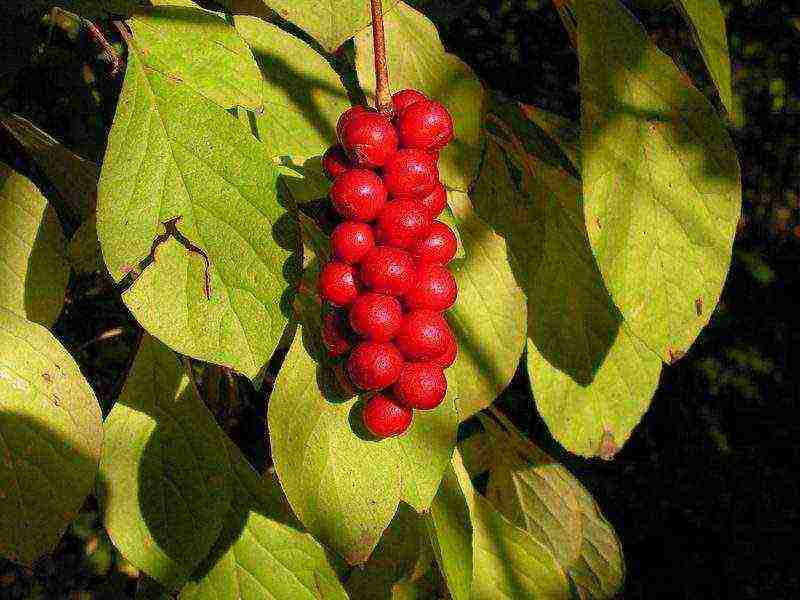
In the Moscow region, only seedlings need shelter in the first year. Further, the vine does not need to be covered, or removed from the support. For Chinese schisandra, the climate of the Middle Lane can be called ideal.
In the Urals and Siberia, even adult vines will need shelter. They should be carefully removed from the trellis, laid on a layer of spruce branches and covered on top with a thick layer of sawdust or leaves.
For the rest, the cultivation of crops by region does not differ.
Planting a plant
Its further growth rate, as well as productivity, directly depends on the correct planting of Schisandra chinensis. The plant is not only useful, but also decorative, which is why it can be placed in the front part of the garden.
Site selection and soil requirements
When choosing a landing site, first of all pay attention to its illumination. The culture needs sun, but it feels good in the openwork shade of the garden, braiding the trunks of neighboring trees. It is important that the area where lemongrass grows is well protected from the wind. The ideal place is considered to be the south side of the existing gazebos, fences, trellises and pergolas. Planting Chinese lemongrass under the wall of a house is not the best solution, since the liana, growing, will gradually destroy the roof, and the streams of water during the rain will damage it itself. If you still have to plant a plant near the house, then at least 1.5 m must be retreated from the wall in order to protect it from drains from above.
The soil for the vine needs nutritious and loose. To prevent the plant from getting wet at the bottom of the planting pit, it is imperative to arrange drainage. For this, broken brick or slate is used.
The optimal soil is a mixture of the following components, taken in the same amount:
- sod land;
- humus;
- compost;
- wood ash.
All components must be mixed well. When planting, 200 g of superphosphate is added under each plant.
How and when to plant?
Depending on climatic conditions, lemongrass is planted from late April to mid-May. The colder it is, the later the planting of the culture. In the southern regions, planting can be carried out in October. Here, it is preferable to spring, since, taking root in a new place, the vine will not suffer from the summer heat, and due to the absence of severe frosts, it will be able to fully take root.
It is better that the number of planted plants is 3 or more, as this gives the maximum decorative effect. The distance between them must be at least 1 meter.
A pit 40 cm deep and 60 cm wide is being prepared for a lemongrass seedling. A drainage layer 10 cm thick is placed on its bottom. After that, the soil is filled up.
For planting, it is better to choose seedlings 2-3 years old. They are not tall, but at the same time they have formed a powerful root system and take root well. The viability of such planting material is maximum.
Growing Chinese Schisandra from seeds
Growing a crop through planting seeds is possible, although more time consuming.Sowing lemongrass is carried out in April-May. Pre-planting material must be stratified. In the fall, seeds are mixed with sand, which is slightly moistened, and stored at a temperature of +5 degrees in a refrigerator or basement. Once every 2 weeks, they are taken out for airing and mixed again. If necessary, the sand is additionally moistened with cold settled water.
2 months before planting, the seeds are moved to heat: for 30 days they are at room temperature, then for another 30 days the seeds are placed in a place with a temperature of +8 degrees. It is important to ensure that the sand does not dry out during the entire period of stratification.

For sowing seeds, peat and sand are mixed in equal parts. Seeds are sown in grooves to a depth of 2 cm, covered with peat and sand and watered. Above the bed, you need to install the bows and stretch the film. You can also sow lemongrass in a greenhouse.
Crops should be watered only in the heat and only in the morning. When sprouts appear, they will need to be shaken off after each watering. This is necessary to prevent decay. Excessive moisture for young plants is extremely dangerous.
When planting in a capital greenhouse, lemongrass does not need shelter for the winter. If the culture was grown with seeds in a greenhouse, then young plants to protect from the cold must be covered with spruce branches, or covered with sawdust. Chinese lemongrass is transplanted to a permanent place in the spring after the first wintering.
Vegetative planting method
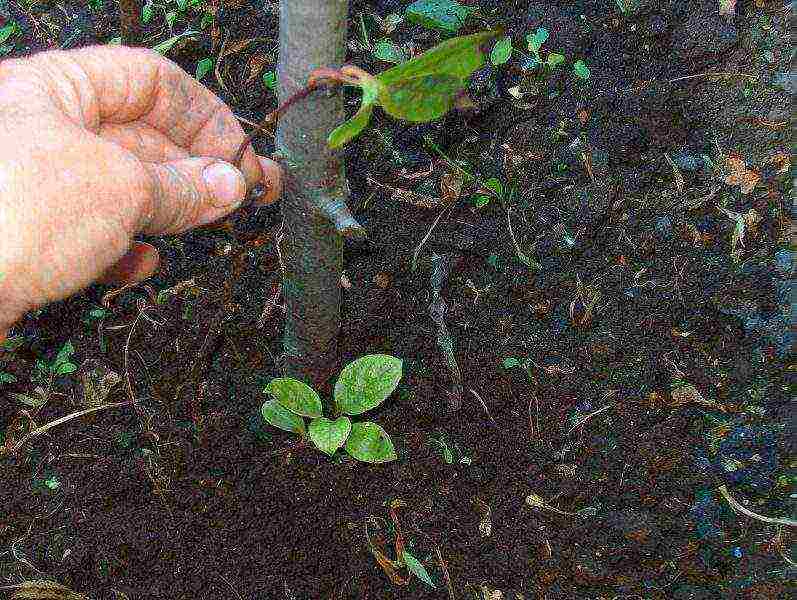
At home, growing a plant can also be carried out through a vegetative planting method. With him, shoots are dug from the root of the plant. Also, the planting of the purchased plant belongs to vegetative planting. Planting is carried out as described above in prepared pits with humus.
Lemongrass care at home
In addition to proper planting, for the well-being of the vine, it also needs proper care, which includes:
- watering;
- top dressing;
- pruning;
- preparation of culture for winter.
With mistakes in leaving, Chinese magnolia vine begins to grow worse and gradually withers away.
Watering and feeding
Competent watering and feeding ensure high-quality plant growth and abundant fruiting.
In nature, lemongrass grows on moist soils, therefore, in a garden, it also needs high-quality moisture. Adult plants in the heat must be sprayed with warm water and watered, pouring 50 liters of water under each in one watering.
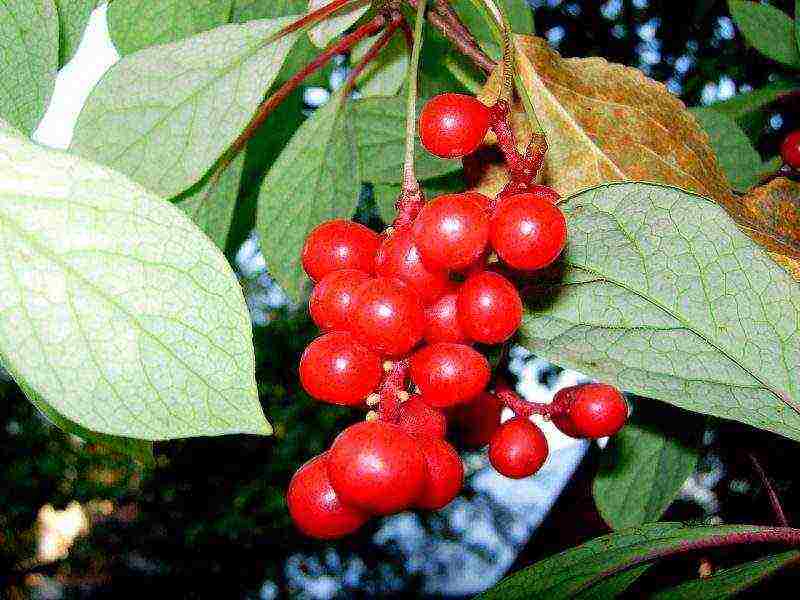
Wet soil is immediately mulched. This is necessary due to the fact that the roots of Schizandra are located very close to the soil surface and can easily dry out in the heat.
Plant feeding is required from the age of 3 years. The main top dressing is organic fertilizers in liquid form. In the summer, chicken manure diluted in water in a ratio of 1:20 is applied under the vine 1 time in 3 weeks. In the spring, lemongrass is fertilized with 1.5 tablespoons of saltpeter per adult plant, and in the fall, at the beginning of September, 30-40 g / m2 of superphosphate and potassium salt each. If they are absent, you can use ordinary wood ash. Compositions with chlorine are harmful for lemongrass.
Pruning
Pruning schisandra chinensis is carried out according to certain rules. In the early years, it is not required, since the vine during this period is actively gaining root mass, and the aerial part grows slowly.
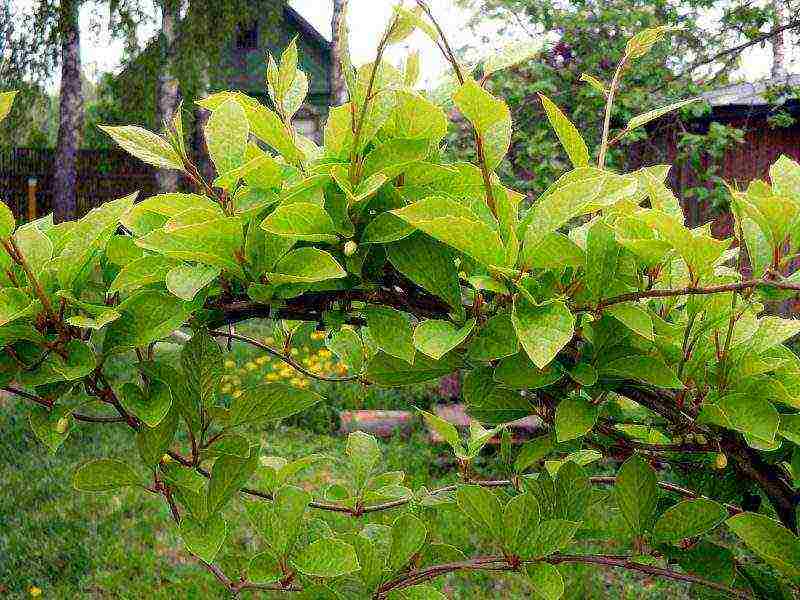
After winter, only the extra root shoots are cut off from the liana. Sanitary pruning, in which damaged and dry branches are removed, is carried out exclusively in the fall after the end of sap flow. Then the thickening shoots are cut off. Only 3 of the strongest processes should be left on the liana. This will greatly simplify maintenance and increase its yield.
Once every 8 years, it is necessary to replace shoots, since, as they age, they begin to bear fruit worse. For this, 2 strong root shoots are left on one old shoot. When they have developed enough, they choose the best one; and the old shoot and the weaker young are cut out.
Support
Lemongrass is a climbing plant and needs support for vertical growth. Without it, it will not fully develop and bear fruit. Only on the trellis, Chinese magnolia vine receives a sufficient amount of light and the necessary ventilation. All-round access to air is vital for him.
For support, pillars with a height of 3 meters are suitable. They are dug into the ground by 50 cm. A strong twine is pulled between them, and a vine is tied to it. As it grows up, the garter is held higher. As a result, the plant has a horizontal support in several tiers between the pillars. When the vine reaches its maximum length, it begins to hang over the upper twine, forming a roller. This usually occurs 1-2 years before replacing the shoot.
Preparing a plant for wintering
In the Middle Lane, there is no need to prepare lemongrass for winter. Shelter is required for young seedlings only in the first winter, if they are not grown in a greenhouse. Adult plants only take shelter in cold climates. If the vine cannot be put on the ground to cover it with spruce branches or sawdust, then it should be wrapped with covering material and tied with spruce branches on top.
Plant diseases and pests
Schisandra chinensis is highly resistant to diseases and, with proper care in the garden, practically does not suffer from them. For pests, the culture is also not of great interest because of its specific resinous smell.
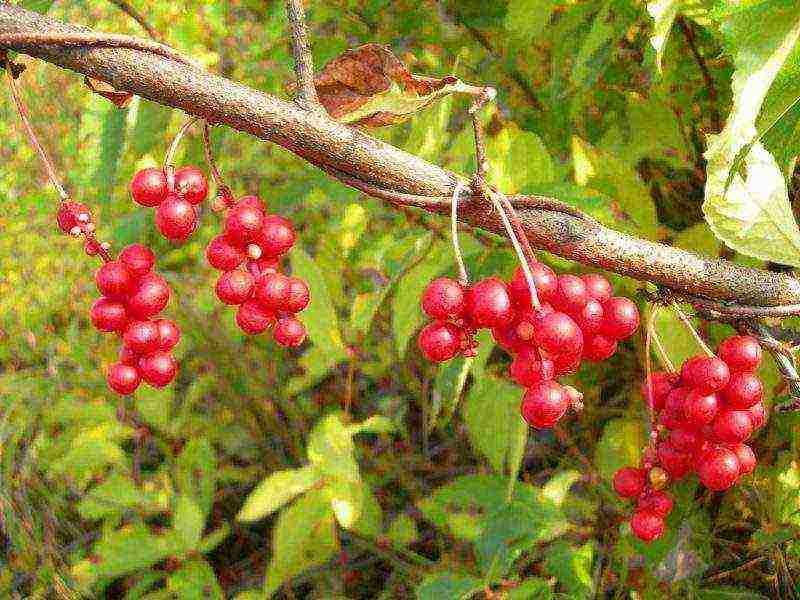
In rare cases, lemongrass affects:
- powdery mildew;
- spotting;
- fusarium wilting - the plant cannot be saved, it should be completely removed and burned.
To eliminate the first two diseases, the affected leaves must be cut from the vines and burned. The very same should be sprayed with a 1% solution of Bordeaux liquid.
Collection and storage of lemongrass fruits
Chinese lemongrass begins to bear fruit at the age of 6. In the first years, the harvest is insignificant, but after 2-4 years it reaches its maximum. The berries are harvested when they turn translucent red. Also, the fruits should be soft. Picking berries, so as not to crush them, is easier with brushes. In addition, the stalks are also used for medicinal purposes.
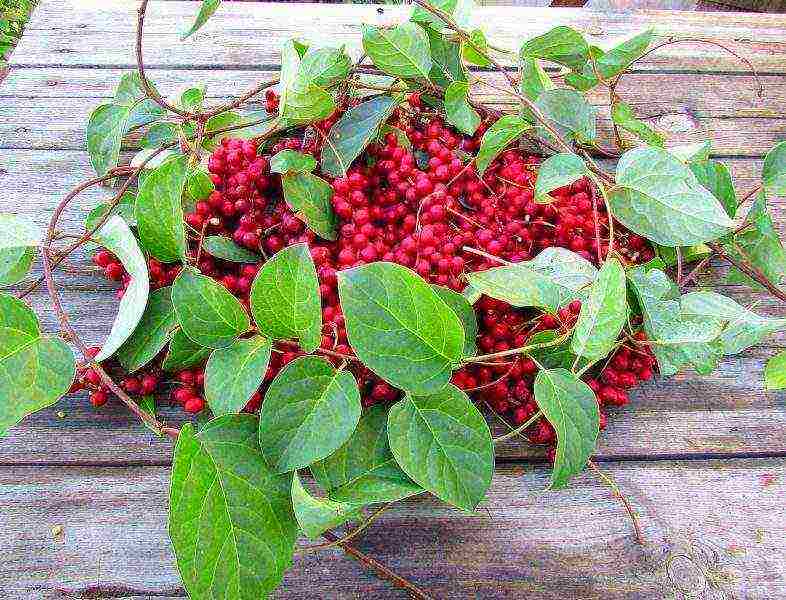
The berries should be processed within a day, since with longer storage they begin to deteriorate. You can rub them with sugar or freeze them. Also, the berries insist on vodka to obtain an effective tonic preparation.
Schisandra chinensis is rightfully called a unique plant that combines decorative and medicinal properties. Therefore, the cultivation of lemongrass has been popular with gardeners for many years.
